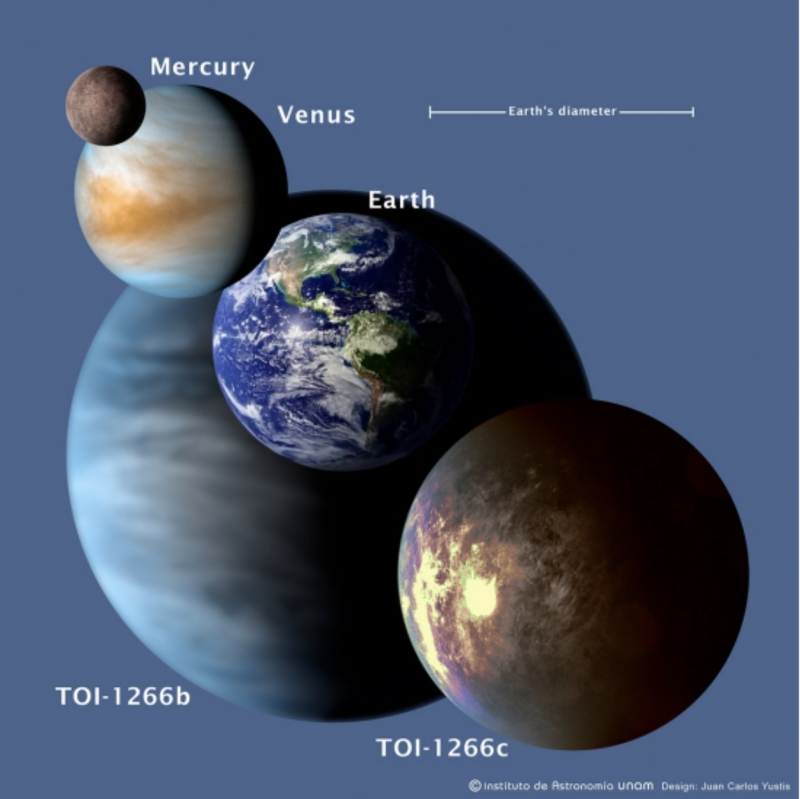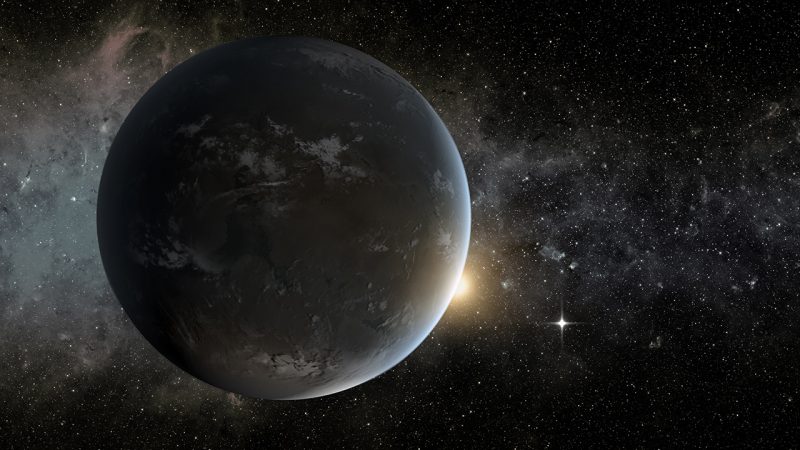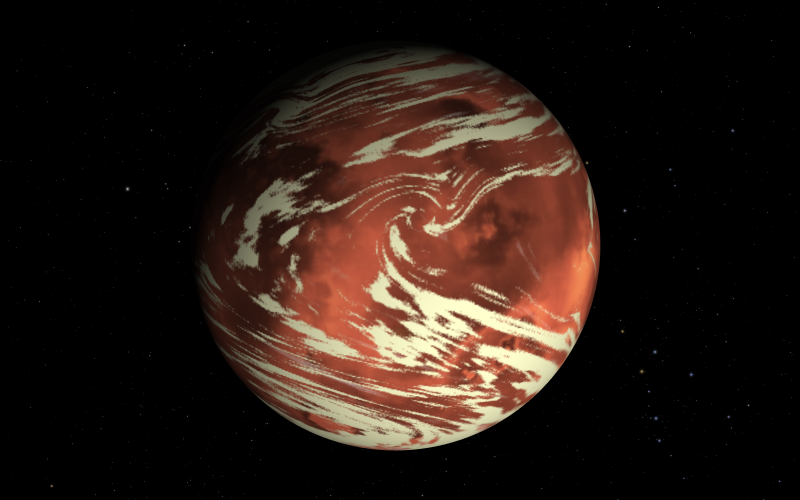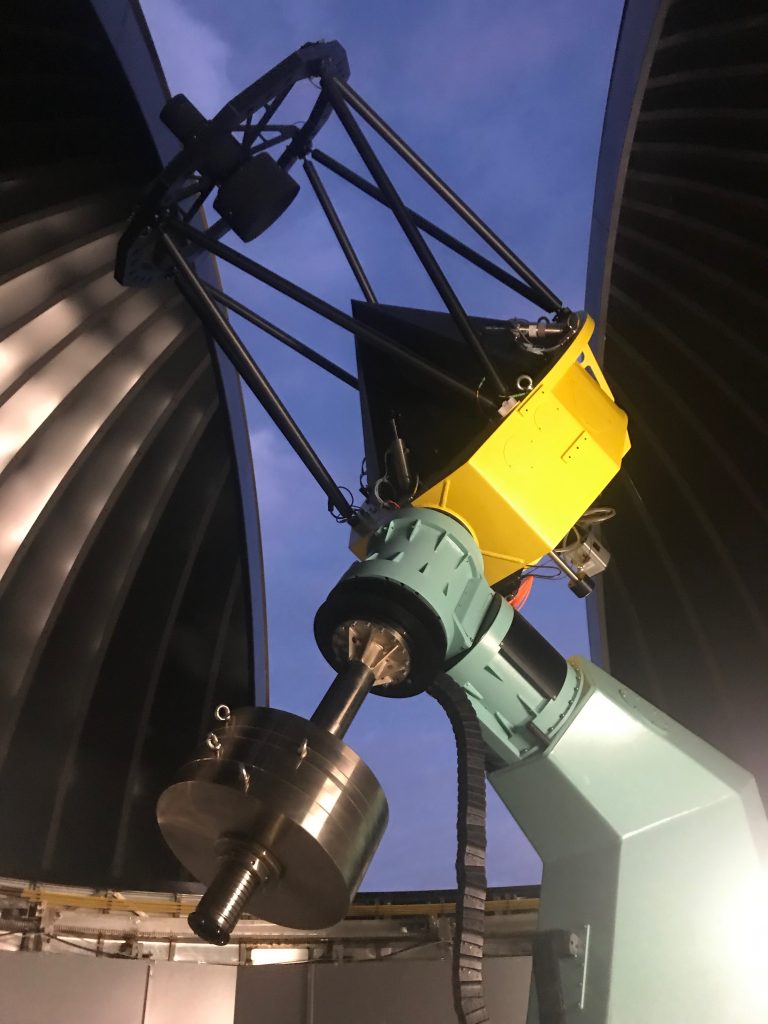

Size comparison of TOI-1266 b, TOI-1266 c, Earth, Venus and Mercury. Image via Institute of Astronomy, UNAM/ Juan Carlos Yustis/ Centauri Dreams.
Astronomers have discovered exoplanets orbiting various types of distant stars, including small, cool red dwarfs, which are the most common kind of star in our galaxy. Now, astronomers from the University of Bern using the SAINT-EX Observatory in Mexico have reported the discovery of two more planets orbiting the red dwarf star TOI-1266, 120 light-years from Earth. The two are an interesting study in red dwarf planets – perhaps the most common sorts of planets in our Milky Way galaxy – in part because they demonstrate how orbiting such a star affects these worlds’ chances to be life-bearing.
The innermost of the two planets – TOI-1266 b – is just under 2 1/2 times Earth’s diameter and so is classified as a sub-Neptune (smaller than Neptune but much larger than Earth). The outer planet – TOI-1266 c – is just over 1 1/2 times Earth’s diameter, making it a super-Earth (smaller than Neptune but a bit larger than Earth).
We’re calling them “inner” and “outer,” but in fact both planets orbit quite close to their star, completing their orbits in only 11 days and 19 days, respectively. That’s a common scenario for the red dwarf planets discovered so far; they orbit near their stars. If the star were sunlike, planets at such close distances would be completely scorched. But TOI-1266 is a red dwarf, smaller and cooler than our sun. The inner planet – the sub-Neptune, TOI-1266 b – has temperatures similar to that of our sun’s second planet Venus, a world hot enough on its surface to melt lead (not only because of its nearness to the sun, but mainly because its thick clouds trap heat in a greenhouse effect). This planet orbits seven times closer to its star than Venus does to the sun.
The researchers published their peer-reviewed findings in the October 2020 issue of Astronomy & Astrophysics.

The orbital distances of the 2 exoplanets discovered around the star TOI-1266, which is half of the size of our sun, are smaller than Mercury’s orbital distance. Image via Institute of Astronomy, UNAM/ Juan Carlos Yustis/ Centauri Dreams.
Despite their larger size compared to planets in our sun’s inner solar system, the two planets orbiting TOI 1266 have similar densities, possibly half rocky/metallic material and half water. If so, they would be about half as rocky as Earth, but far rockier than Neptune or Uranus, which are classified as ice giants.
These characteristics make the planets rather unique, placing them at the edges of the so-called radius-valley or small planet radius gap. This is where there is a scarcity of planets with radii between 1 1/2 and 2 times Earth’s radius. Scientists still aren’t sure why there is this gap, but it may have to do with photoevaporation – caused by ultraviolet radiation from the host stars – which would drive atmospheric mass loss on close-in, low-mass planets. As Brice-Olivier Demory, lead author of the study at the University of Bern, stated:
Planets between about the radius of TOI-1266 b and c are quite rare, likely because of the effect of strong irradiation from the star, which can erode their atmospheres.
Yilen Gómez Maqueo Chew, SAINT-EX Project Coordinator at the National Autonomous University of Mexico, added:
Being able to study two different types of planets in the same system is a great opportunity to better understand how these different sized planets come to be.

Artist’s concept of TOI-1266 b, a sub-Neptune exoplanet discovered orbiting the red dwarf star TOI-1266. Image via NASA.

Artist’s concept of TOI-1266 c, a super-Earth exoplanet discovered orbiting the red dwarf star TOI-1266. Image via NASA.
Even though red dwarfs are so common, their smaller size and relative dimmness make them harder to observe than sun-like stars, as Demory noted:
But these stars are rather small and emit little light compared to most other stars, such as our sun.
SAINT-EX Observatory is fully robotic and uses a 1-meter telescope specifically designed for high-precision detection of small planets orbiting cool stars such as TOI-1266.
As with many other observatories, observations were cut short due to the Covid-19 pandemic, but luckily the researchers were able to finish their study of these two new exoplanets beforehand. It is hoped that observations will be able to resume within the next few months. Demory said:
Also, the Mexican Embassy in Bern was a great help in facilitating the discussions with the Mexican government and in providing continued support to the project.

Brice-Olivier Demory at the University of Bern, lead author of the new study. Image via University of Bern.
Exoplanets have been discovered orbiting many red dwarfs now. Some of these planets are super-Earths, as with Gliese-887, which has at least two known super-Earth planets. They were reported last July, and discovered by researchers at the University of Göttingen in Germany.
Last month, it was reported that Gliese-887 is more active with dangerous flare activity than had been previously thought. This could make it difficult, although not impossible, for life to survive on its planets. Intense flares like these are common on red dwarfs, and they can potentially strip the atmospheres off planets that orbit too close.
In 2014, another study suggested that almost every red dwarf should have at least one planet. Since red dwarfs are the most common stars in our galaxy, that’s a lot of planets!

The SAINT-EX Observatory at the National Astronomical Observatory in Mexico. Image via University of Bern.
Since red dwarf stars are the most common in our galaxy, and super-Earths and sub-Neptunes are two of the most common types of planets found so far, there should be many more worlds like TOI-1266 b and TOI-1266 c out there. Some of those should be potentially habitable, so it will be exciting to see how many more such worlds are found in the next few years.
Bottom line: Two more exoplanets – a super-Earth and a sub-Neptune – have been found orbiting a red dwarf star 120 light-years from Earth.
Source: A super-Earth and a sub-Neptune orbiting the bright, quiet M3 dwarf TOI-1266
from EarthSky https://ift.tt/3kwIEJ4


Size comparison of TOI-1266 b, TOI-1266 c, Earth, Venus and Mercury. Image via Institute of Astronomy, UNAM/ Juan Carlos Yustis/ Centauri Dreams.
Astronomers have discovered exoplanets orbiting various types of distant stars, including small, cool red dwarfs, which are the most common kind of star in our galaxy. Now, astronomers from the University of Bern using the SAINT-EX Observatory in Mexico have reported the discovery of two more planets orbiting the red dwarf star TOI-1266, 120 light-years from Earth. The two are an interesting study in red dwarf planets – perhaps the most common sorts of planets in our Milky Way galaxy – in part because they demonstrate how orbiting such a star affects these worlds’ chances to be life-bearing.
The innermost of the two planets – TOI-1266 b – is just under 2 1/2 times Earth’s diameter and so is classified as a sub-Neptune (smaller than Neptune but much larger than Earth). The outer planet – TOI-1266 c – is just over 1 1/2 times Earth’s diameter, making it a super-Earth (smaller than Neptune but a bit larger than Earth).
We’re calling them “inner” and “outer,” but in fact both planets orbit quite close to their star, completing their orbits in only 11 days and 19 days, respectively. That’s a common scenario for the red dwarf planets discovered so far; they orbit near their stars. If the star were sunlike, planets at such close distances would be completely scorched. But TOI-1266 is a red dwarf, smaller and cooler than our sun. The inner planet – the sub-Neptune, TOI-1266 b – has temperatures similar to that of our sun’s second planet Venus, a world hot enough on its surface to melt lead (not only because of its nearness to the sun, but mainly because its thick clouds trap heat in a greenhouse effect). This planet orbits seven times closer to its star than Venus does to the sun.
The researchers published their peer-reviewed findings in the October 2020 issue of Astronomy & Astrophysics.

The orbital distances of the 2 exoplanets discovered around the star TOI-1266, which is half of the size of our sun, are smaller than Mercury’s orbital distance. Image via Institute of Astronomy, UNAM/ Juan Carlos Yustis/ Centauri Dreams.
Despite their larger size compared to planets in our sun’s inner solar system, the two planets orbiting TOI 1266 have similar densities, possibly half rocky/metallic material and half water. If so, they would be about half as rocky as Earth, but far rockier than Neptune or Uranus, which are classified as ice giants.
These characteristics make the planets rather unique, placing them at the edges of the so-called radius-valley or small planet radius gap. This is where there is a scarcity of planets with radii between 1 1/2 and 2 times Earth’s radius. Scientists still aren’t sure why there is this gap, but it may have to do with photoevaporation – caused by ultraviolet radiation from the host stars – which would drive atmospheric mass loss on close-in, low-mass planets. As Brice-Olivier Demory, lead author of the study at the University of Bern, stated:
Planets between about the radius of TOI-1266 b and c are quite rare, likely because of the effect of strong irradiation from the star, which can erode their atmospheres.
Yilen Gómez Maqueo Chew, SAINT-EX Project Coordinator at the National Autonomous University of Mexico, added:
Being able to study two different types of planets in the same system is a great opportunity to better understand how these different sized planets come to be.

Artist’s concept of TOI-1266 b, a sub-Neptune exoplanet discovered orbiting the red dwarf star TOI-1266. Image via NASA.

Artist’s concept of TOI-1266 c, a super-Earth exoplanet discovered orbiting the red dwarf star TOI-1266. Image via NASA.
Even though red dwarfs are so common, their smaller size and relative dimmness make them harder to observe than sun-like stars, as Demory noted:
But these stars are rather small and emit little light compared to most other stars, such as our sun.
SAINT-EX Observatory is fully robotic and uses a 1-meter telescope specifically designed for high-precision detection of small planets orbiting cool stars such as TOI-1266.
As with many other observatories, observations were cut short due to the Covid-19 pandemic, but luckily the researchers were able to finish their study of these two new exoplanets beforehand. It is hoped that observations will be able to resume within the next few months. Demory said:
Also, the Mexican Embassy in Bern was a great help in facilitating the discussions with the Mexican government and in providing continued support to the project.

Brice-Olivier Demory at the University of Bern, lead author of the new study. Image via University of Bern.
Exoplanets have been discovered orbiting many red dwarfs now. Some of these planets are super-Earths, as with Gliese-887, which has at least two known super-Earth planets. They were reported last July, and discovered by researchers at the University of Göttingen in Germany.
Last month, it was reported that Gliese-887 is more active with dangerous flare activity than had been previously thought. This could make it difficult, although not impossible, for life to survive on its planets. Intense flares like these are common on red dwarfs, and they can potentially strip the atmospheres off planets that orbit too close.
In 2014, another study suggested that almost every red dwarf should have at least one planet. Since red dwarfs are the most common stars in our galaxy, that’s a lot of planets!

The SAINT-EX Observatory at the National Astronomical Observatory in Mexico. Image via University of Bern.
Since red dwarf stars are the most common in our galaxy, and super-Earths and sub-Neptunes are two of the most common types of planets found so far, there should be many more worlds like TOI-1266 b and TOI-1266 c out there. Some of those should be potentially habitable, so it will be exciting to see how many more such worlds are found in the next few years.
Bottom line: Two more exoplanets – a super-Earth and a sub-Neptune – have been found orbiting a red dwarf star 120 light-years from Earth.
Source: A super-Earth and a sub-Neptune orbiting the bright, quiet M3 dwarf TOI-1266
from EarthSky https://ift.tt/3kwIEJ4

Aucun commentaire:
Enregistrer un commentaire